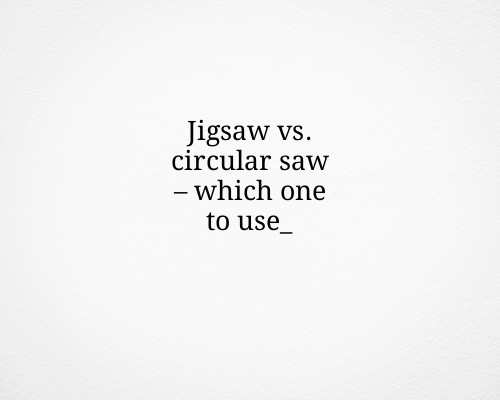When deciding between a jigsaw and a circular saw, it’s important to consider the specific tasks you’ll be tackling in your woodworking project. Both tools have their strengths, but they excel in different scenarios. Here’s a breakdown of each:
1. Jigsaw
A jigsaw is ideal for precision and versatility. It’s perfect for cutting curves, intricate patterns, and tight corners. The blade of the jigsaw moves up and down (or sometimes side to side) in a reciprocating motion, which allows it to follow the shape of the material being cut.
When to Use a Jigsaw:
- Curved Cuts: If your project involves cutting arcs or irregular shapes, the jigsaw is the go-to tool.
- Tight Spaces: For smaller, confined spaces where a circular saw won’t fit, a jigsaw can maneuver more easily.
- Thickness of Material: Jigsaws can cut through thinner materials, like plywood, MDF, or softwood, but they can also handle some thicker materials with the right blade.
- Fine Detail: The jigsaw’s fine blade allows for detailed, controlled cuts, which is especially useful for projects like cabinetry or decorative woodworking.
Pros:
- Excellent for intricate cuts.
- Versatile for a variety of materials (wood, metal, plastic).
- Portability and ease of use for beginners.
Cons:
- Not ideal for long, straight cuts.
- Cutting speed is slower than that of a circular saw.
2. Circular Saw
A circular saw is designed for fast, straight cuts. It uses a toothed blade that spins around a central axis, cutting through wood and other materials. Circular saws are often used for larger and more demanding projects where speed and power are key.
When to Use a Circular Saw:
- Straight Cuts: If you need long, straight cuts, the circular saw is your best bet. It’s perfect for cutting plywood sheets, lumber, and other long pieces of wood.
- Thick Materials: Circular saws are great for cutting thicker materials like hardwoods, MDF, or even plywood up to 2-3 inches thick.
- Speed: Circular saws allow you to make quick, straight cuts, making them ideal for rough cuts or framing.
Pros:
- Great for cutting large, thick materials.
- Faster cutting speed.
- More powerful than a jigsaw, making it better suited for tough materials.
Cons:
- Not suitable for curved or intricate cuts.
- Less maneuverable in tight spaces compared to a jigsaw.
Summary:
- Use a Jigsaw for detailed, curved cuts, and when working with smaller, more intricate pieces.
- Use a Circular Saw for long, straight cuts and when working with thicker materials or when you need to cut quickly and efficiently.
Choosing the right saw depends on the nature of your project, so consider both the types of cuts you need and the materials you’re working with.
